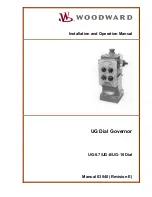
Manual 03040
UG Dial Governor
Woodward
7
Oil Supply
Use an oil depending on operating temperature for the governor (see Table 2-1).
Primary concern is for the oil properties in the governor.
Fill the governor with approximately two quarts of oil to the mark on the oil sight
glass. After the engine is started and the governor is at operating temperature,
add oil if necessary. Oil must be visible in the glass under all operating
conditions.
Use the information given in Tables 2-1 and 2-2 as a guide in the selection of a
suitable lubricating/hydraulic oil. Oil grade selection is based on the operating
temperature range of the governor. Also, use this information to aid in
recognizing and correcting common problems associated with oils used in
governors.
For applications where the governor shares the oil supply with the engine, use
the oil recommended by the engine manufacturer.
Governor oil is both a lubricating oil and a hydraulic oil. It must have a viscosity
index that allows it to perform over the operating temperature range, and it must
have the proper blending of additives that cause it to remain stable and
predictable throughout this range.
Governor oil must be compatible with seal materials (particularly nitrile,
polyacrylic, and fluorocarbon). Many automotive and gas engine oils, industrial
lubricating oils, and other oils of mineral or synthetic origin meet these
requirements. Woodward governors are designed to give stable operation with
most oils with the viscosity, at the operating temperature, between 50 and 3000
SUS (Saybolt Universal Seconds). At the normal operating temperature, the
viscosity should be between 100 to 300 SUS. Poor actuator response or
instability may be an indication that the oil viscosity is outside this range.
Excessive component wear or seizure in a governor indicates the possibility of:
1.
Insufficient lubrication caused by:
a.
An oil that flows slowly when it is cold, especially during start-up.
b.
No oil in the governor.
2.
Contaminated oil caused by:
a.
Dirty oil containers.
b.
A governor exposed to heating up and cooling down cycles, which
creates condensation of water in the oil.
3.
Oil not suitable for the operating conditions caused by:
a.
Changes in ambient temperature.
b.
An improper oil level which creates foamy, aerated oil.
Содержание UG-10 Dial
Страница 1: ...Installation and Operation Manual UG Dial Governor UG 5 7 UG 8 UG 10 Dial Manual 03040 Revision E...
Страница 5: ...Manual 03040 UG Dial Governor Woodward iii...
Страница 6: ...UG Dial Governor Manual 03040 iv Woodward Figure 1 1 UG 8 Dial Governor...
Страница 9: ...Manual 03040 UG Dial Governor Woodward 3 Figure 1 3 UG Dial Governor Outline Drawing...
Страница 14: ...UG Dial Governor Manual 03040 8 Woodward Table 2 1 Oil Chart Table 2 2 Viscosity Comparisons...
Страница 18: ...UG Dial Governor Manual 03040 12 Woodward Figure 3 1 UG Dial Governor Schematic Diagram...
Страница 43: ...Manual 03040 UG Dial Governor Woodward 37 Figure 6 1a Parts Illustration for the UG Dial Governor...
Страница 45: ...Manual 03040 UG Dial Governor Woodward 39 Figure 6 1b Parts Illustration for the UG Dial Governor...
Страница 47: ...Manual 03040 UG Dial Governor Woodward 41 Figure 6 1c Parts Illustration for the UG Dial Governor...
Страница 49: ...Manual 03040 UG Dial Governor Woodward 43 Figure 6 1d Parts Illustration for the UG Dial Governor...
Страница 51: ...Manual 03040 UG Dial Governor Woodward 45 Figure 6 1e Parts Illustration for the UG Dial Governor...




























